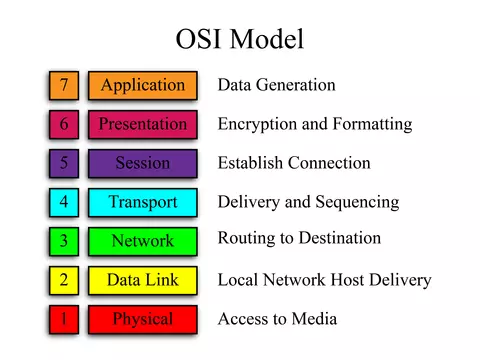The Open Systems Interconnection (OSI) model is a data model developed by the International Organization for Standardization that allows the use of standard protocols for the communication of different communication systems. The OSI sets a framework for various computer systems to be able to communicate with each other in plain English.
The OSI model can be viewed as a standard computer-networking language. It is based on the concept of separating a communication system into seven abstract layers, each layered on the last layer. Through OSI model layer performs a different job and interacts with the layers above and below themselves.
Why does the OSI model matter?
While the modern Internet is not strictly following the OSI model (it follows the easier Internet protocol suite more closely), the OSI model is still very useful for configuring network issues. Whether it’s one person who can’t get their laptop on the Web, or a website that’s down for thousands of users, the OSI model can help clear the problem down and identify the root of the trouble. If the issue can be reduce to one particular layer of the model, it can avoid a lot of unnecessary work.
What are the seven layers of the OSI model?
The seven abstraction layers of the OSI model can be define as follows, from top to bottom:
The Application Layer
This is the only layer that interacts directly with the user’s data. Software applications such as web browsers and email clients depend on the application layer for contact initiation. But it should be clarified that client software applications are not part of the application layer; rather, the application layer is concerned for the protocols and data manipulation on which the program depends in providing useful data to the user. Application layer protocols include both HTTP and SMTP.
The Presentation Layer
This layer is mainly responsible for storing data so that the application layer can use it; in other words, layer 6 makes the data presentable for receiving applications. The presentation layer is responsible for the translation encryption, and data compression.
Two communication devices may use different encoding methods, so that layer 6 is responsible for converting incoming data into a syntax that the receiving device’s application layer can understand.
If the devices communicate over an encrypted connection, it is the duty of layer 6 to add the encryption on the end of the sender as well as to decrypt the encryption at the end of the receiver so that it can present unencrypted, readable data to the application layer.
Eventually, it is also the duty of the presentation layer to compress data which it receives from the application layer before delivering it to layer 5. It helps to improve interaction speed and efficiency by reducing the volume of data to be transmit.
The Session Layer
This is the layer responsible for opening connection between the two devices and closing the connection. The time between the opening and closing of the communication is known as session. The session layer guarantees that the session remains open long enough to pass all the data being exchange, and then closes the session immediately so as not to waste resources.
The session layer also synchronizes the transfer of data to checkpoints. For example, the session layer could set a checkpoint every 5 megabytes if a 100 megabyte file is transferred. In the case of a break or crash after the transfer of 52 megabytes, the session could restore from the last checkpoint, meaning that only 50 more megabytes of data need to be transfer. Without the checkpoints the whole process would have to start from zero again.
The Transport Layer
Layer 4 is in charge of end-to-end communication between both devices. It includes taking and splitting data from the session layer into pieces called segments before sending it to layer 3. The transport layer on the receiving device is responsible for reattaching the segments into data which can be used by the session layer.
Flow control and error correction are also responsibility of the transport layer. Flow control determines the optimum transmission speed to assure that a sender with a fast connection does not overpower a receiver with a slow connection. On the receiving end, the transport layer performs error control by checking that the data receive is accurate and requesting retransmission if not.
The Network Layer
The responsibility for facilitating data transfer between two different networks rests with the network layer. If the two communication devices are in the same network then the layer of the network is pointless. The network layer splits up segments on the sender’s device from the transport layer into smaller units, called packets. Reassembles those packets on the receiving device. Also, the network layer determines the best physical route for the data to reach their destination; this is call routing.
The Data Link Layer
The data link layer is much relate to the network layer. Except that the data link layer allows the transfer of data between two devices on the network. This layer takes packets from the network layer and splits them into smaller chunks called frames. Like the network layer, the data link layer is also responsible for flow control and error control in intra-network communication.
The Physical Layer
This layer contains the physical equipment, such as the cables and switches used in the data transmission. This is also the layer where the data is translate. To a bit stream which is a 1s and 0s string. The physical layer of both devices also needs to agree on a signal standard. So that the 1s on both devices can be isolated from the 0s.




